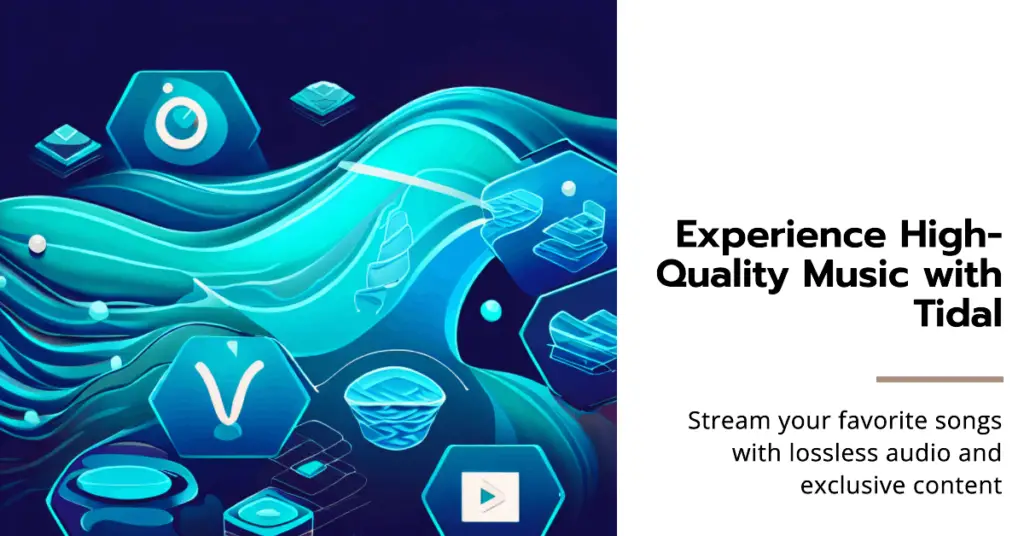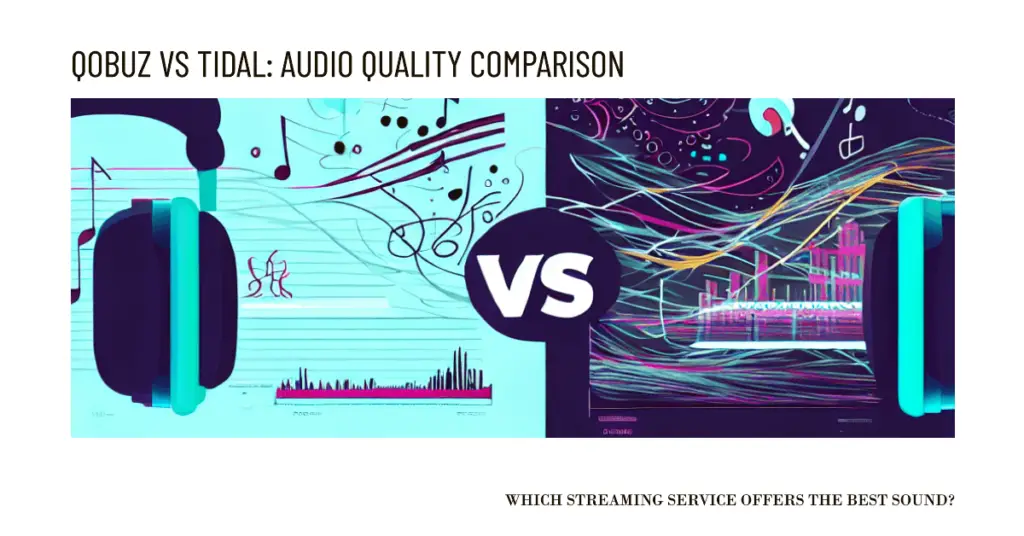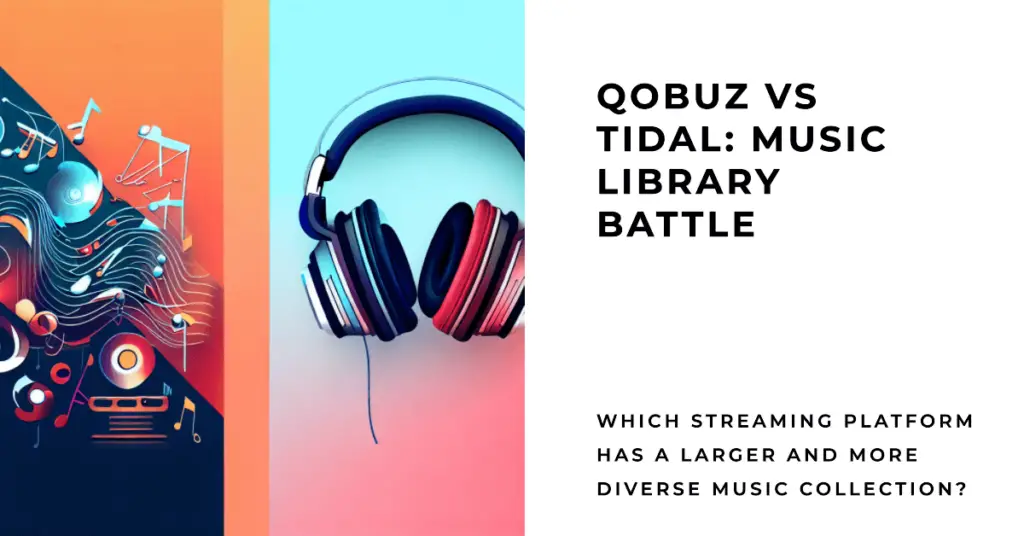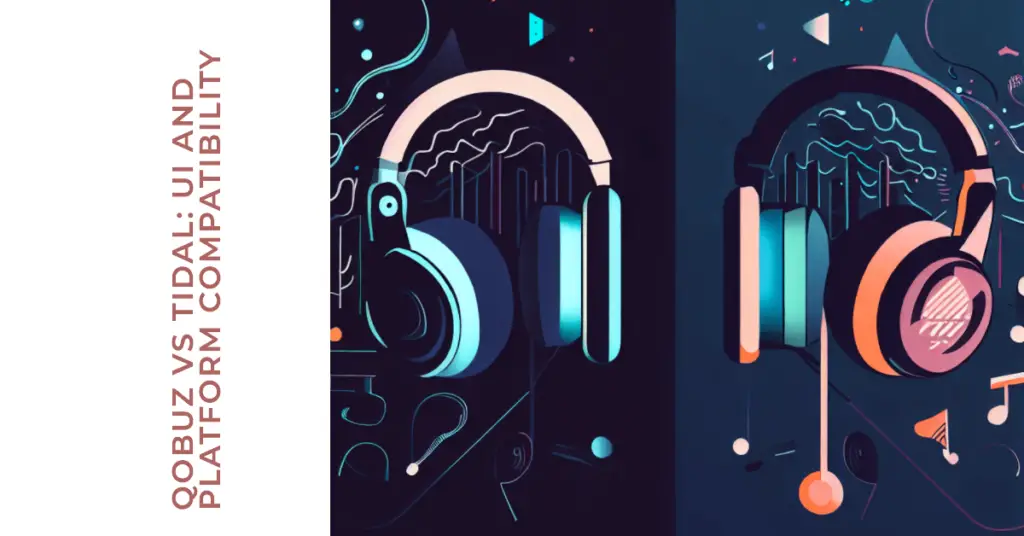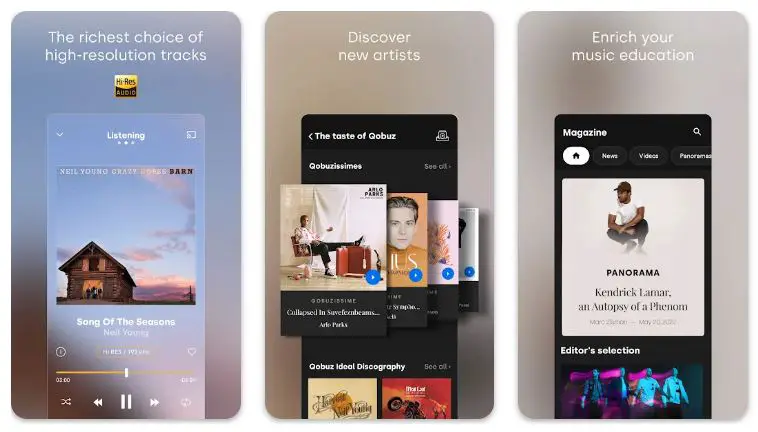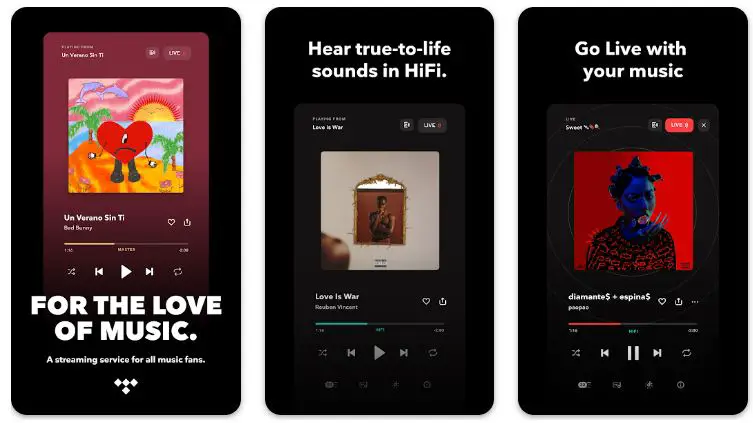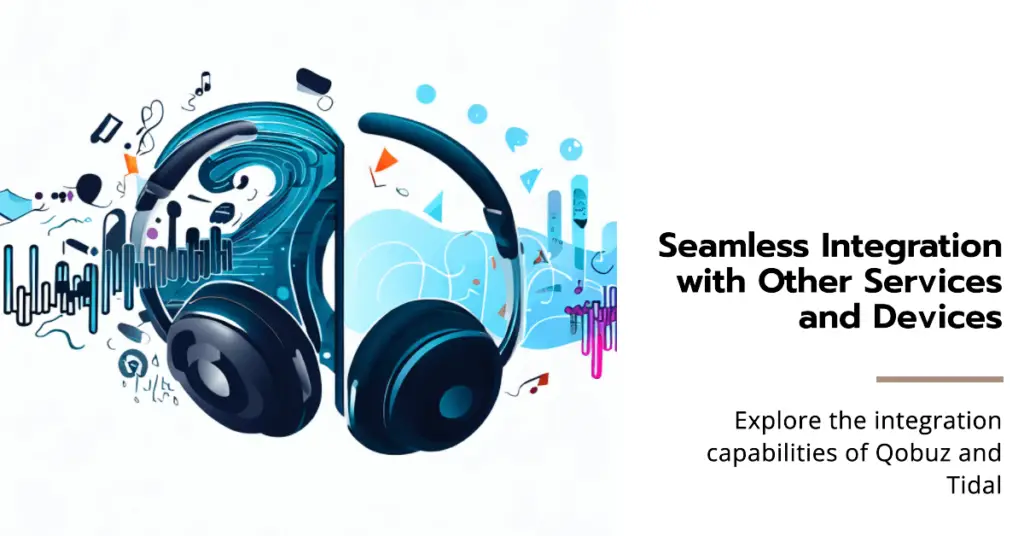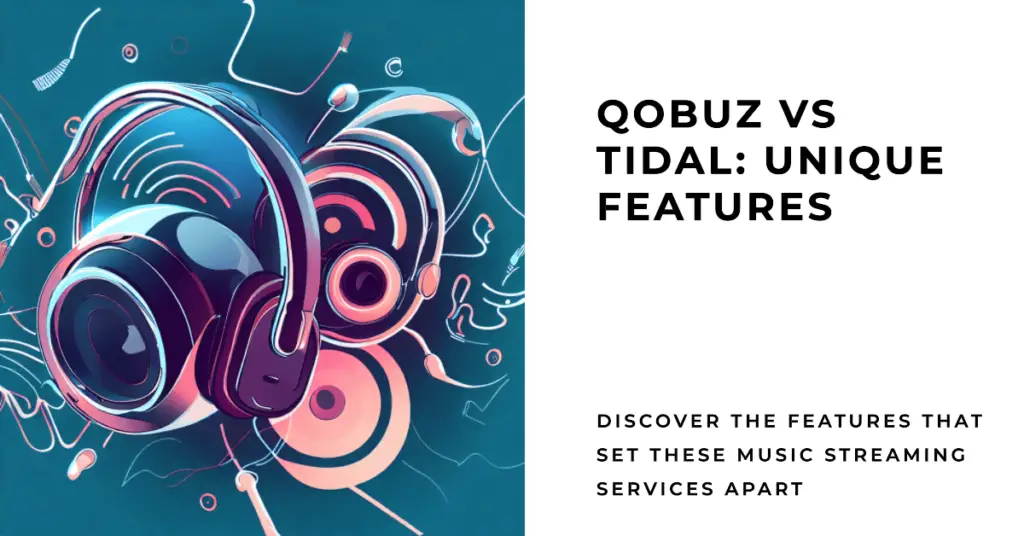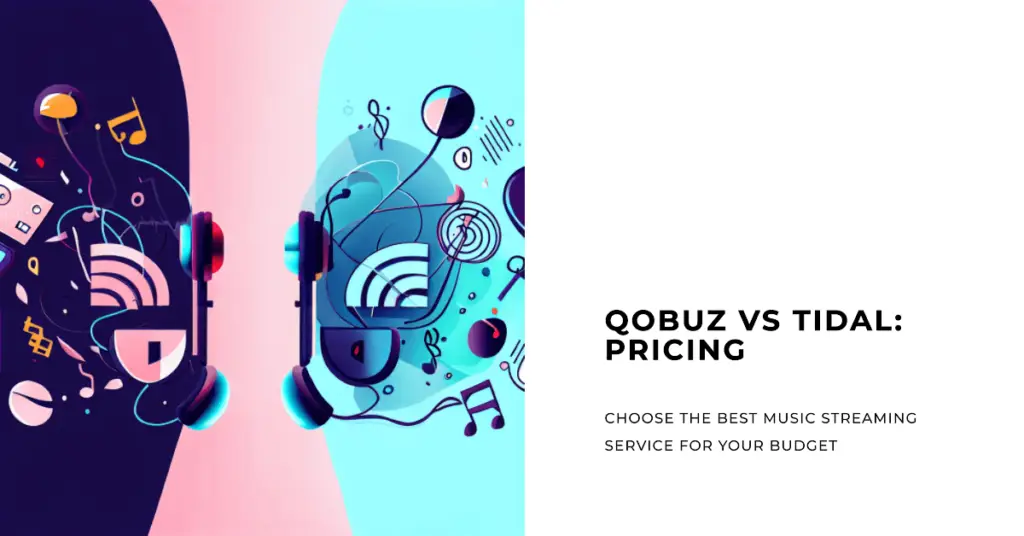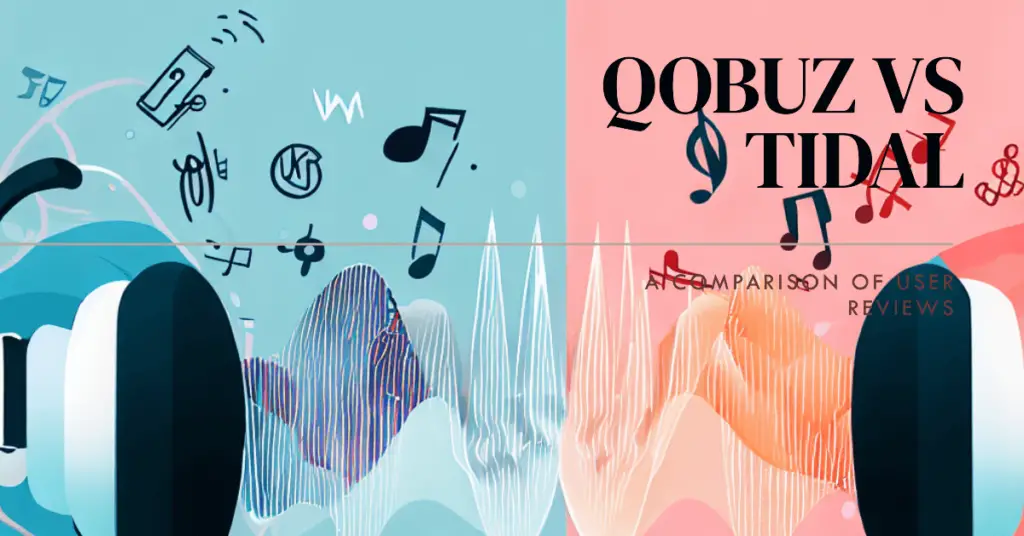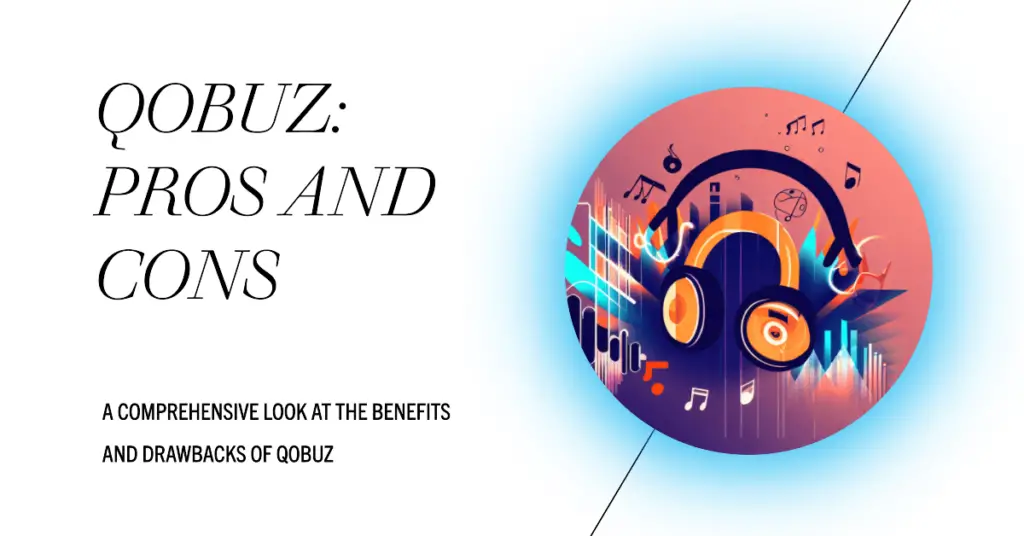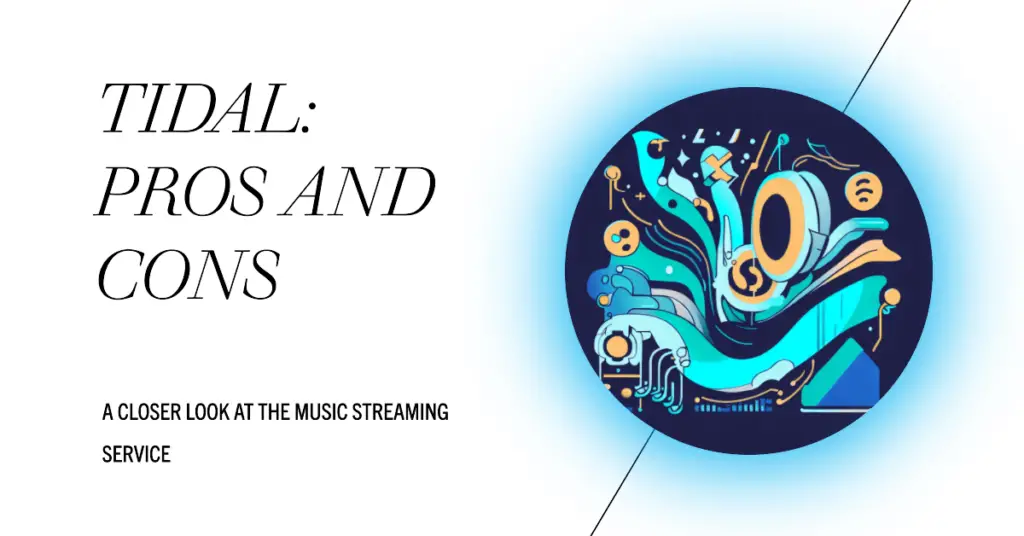Are you tired of mediocre audio quality and uninspiring music libraries? If you’re an audiophile or simply someone who enjoys music in high fidelity, you’ve probably found yourself stuck in a conundrum.
The abundance of music streaming platforms can leave anyone scratching their head, but two platforms stand out when delivering the ultimate audio experience: Qobuz and Tidal.
Both Qobuz and Tidal are renowned for their high-resolution audio streaming, broad musical repertoire, and exclusive content, which sets them apart from competitors.
But picking one becomes a challenging task with two strong contenders in the arena. What if you choose the wrong platform and miss out on a better music experience? What if you overpay for features you don’t need or care about?
This article will tackle the pressing “Qobuz vs Tidal” debate head-on. We’ll comprehensively compare their audio quality, music libraries, unique features, user interfaces, pricing structure, and more.
Whether you’re an audiophile, a casual listener, or somewhere in between, this article aims to help you determine which platform is the right choice for your specific needs and preferences. So sit back, relax, and let’s get started on our musical journey of discovery.
History and Development of Qobuz and Tidal
In the ever-evolving landscape of music streaming, Qobuz and Tidal have emerged as significant players, each with its unique journey of history and development.
Qobuz traces its origins back to 2007 when it became a trailblazer in high-resolution music streaming. With a focus on delivering exceptional audio quality, Qobuz swiftly gained recognition among discerning audiophiles and music enthusiasts.
Its growth trajectory has been marked by expansion on a global scale, catering to an audience seeking a truly immersive music experience. With an extensive catalog boasting over 70 million tracks, including a hi-res music collection, Qobuz continues to captivate subscribers who prioritize superior sound reproduction.
Similarly, Tidal debuted in 2014, aiming to revolutionize the music streaming landscape. Led by notable artists and industry figures, Tidal distinguished itself by emphasizing artist-centric initiatives and high-fidelity audio.
Offering a library of CD-quality music and lossless audio, Tidal aimed to provide an unparalleled listening experience. Despite initial challenges, Tidal steadily grew its user base through exclusive releases and strategic collaborations with renowned artists.
Today, both Qobuz and Tidal occupy prominent positions in the music streaming industry. Qobuz’s commitment to high-resolution audio and expansive library and Tidal’s focus on artist royalties and lossless streaming have positioned them as leaders in their respective niches.
As the streaming landscape continues to evolve, Qobuz and Tidal remain at the forefront, offering unique propositions to satisfy the demands of discerning listeners who prioritize audio quality.
Features of Qobuz
Qobuz, the renowned high-resolution music streaming platform, offers many features designed to provide a premium listening experience for music enthusiasts.
Let’s explore some of the key features of Qobuz that set it apart from other streaming services.
1. Extensive Music Catalog: Qobuz boasts an impressive library of over 70 million tracks, covering a wide range of genres and styles. From mainstream hits to obscure gems, Qobuz caters to diverse musical tastes, ensuring there’s something for everyone.
2. High-Resolution Audio: Qobuz’s commitment to high-resolution audio is one of its defining features. With support for formats such as FLAC and ALAC, Qobuz allows users to enjoy music in studio quality with greater detail and clarity. This emphasis on audio fidelity appeals to audiophiles and those who appreciate the nuances of sound.
3. Lossless Streaming: Qobuz offers lossless streaming options, ensuring the audio quality remains uncompromised during playback. By preserving the original audio data, Qobuz delivers music in its purest form, free from compression artifacts that can degrade the listening experience.
4. Exclusive Content: Qobuz provides access to a range of exclusive content that goes beyond just music. Users can enjoy editorial articles, interviews, and curated playlists crafted by music experts, offering a deeper dive into the world of artists and their craft. This enriches the overall experience and fosters a connection between the listener and the music.
5. Comprehensive Music Metadata: Qobuz prides itself on its meticulous attention to music metadata. Users can access detailed information about albums, tracks, artists, etc. This includes album credits, lyrics, and artist biographies, allowing listeners to delve into the background and context of their favorite music.
6. Social Features: Qobuz incorporates social features that enhance music discovery. Users can follow their favorite artists, receive personalized recommendations, and explore the musical preferences of others within the Qobuz community. This fosters a sense of engagement and facilitates the exploration of new artists and genres.
7. Multi-Platform Support: Qobuz ensures its service is accessible across various platforms. Whether you prefer desktop or mobile listening, Qobuz offers Windows, macOS, iOS, and Android apps and software. This flexibility allows users to enjoy their music seamlessly across different devices.
8. Integration with Hi-Fi Systems: Qobuz understands the importance of integrating with existing audio setups. The platform offers compatibility with a range of hi-fi systems and network players, including those supporting Roon, enabling users to incorporate Qobuz seamlessly into their home audio environments.
9. Music Discovery Tools: Qobuz provides music discovery tools to help users explore new artists and genres. These include personalized recommendations based on listening habits, genre-based browsing, and access to premier curated playlists crafted by music experts. Qobuz facilitates musical exploration and helps users broaden their musical horizons.
10. Offline Listening: Qobuz allows users to download their favorite tracks, albums, and playlists for offline listening. This feature comes in handy when users are on the go or in areas with limited internet connectivity, ensuring uninterrupted access to their music library.
In conclusion, Qobuz offers a range of features that cater to the needs of discerning listeners. From its extensive music catalog and emphasis on high-resolution audio to its exclusive content, social features, and comprehensive music metadata, Qobuz delivers a premium streaming experience.
With its commitment to audio quality and a focus on enhancing music discovery, Qobuz continues to captivate music lovers who seek more than just a standard streaming service.
Download The App From Google Play Store
Download The App From Apple App Store
Features of Tidal
Tidal, a prominent player in the music streaming industry, offers a range of features that elevate the listening experience for its users.
Let’s explore some of the key features of Tidal that set it apart from other streaming platforms.
1. High-Fidelity Audio: Tidal is renowned for emphasizing high-fidelity audio. With its lossless streaming quality, users can enjoy music in CD quality or even higher, capturing the nuances and intricacies of the original recordings. This feature appeals to audiophiles and music enthusiasts who prioritize audio quality.
2. Exclusive Content: Tidal provides access to vast exclusive content. Users can enjoy exclusive music releases, live performances, and intimate interviews with favorite artists. This gives Tidal subscribers an exclusive glimpse into the creative process and offers a deeper connection to the music they love.
3. Tidal Masters: Tidal offers a unique feature called Tidal Masters, which provides access to a growing library of master-quality recordings. These are authenticated and approved by the artists, ensuring the highest level of audio fidelity. Tidal Masters allows users to experience music as the artists intended, with exceptional clarity and detail.
4. Curated Playlists: Tidal boasts a rich collection of curated playlists created by music experts and artists. These playlists cater to various moods, genres, and themes, making it easy for users to discover new music or create personalized listening experiences. Whether you’re in the mood for a relaxing evening or an energizing workout, Tidal’s curated playlists have you covered.
5. Music Videos: Tidal goes beyond audio and incorporates music videos into its platform. Users can explore an extensive library of music videos, concert footage, and documentaries. This integration of visual content adds an extra dimension to the listening experience and allows users to immerse themselves in the world of their favorite artists.
6. Offline Listening: Tidal offers the convenience of offline listening. Users can download their favorite songs, albums, and playlists to enjoy them without an internet connection. This feature is especially useful when traveling or in areas with limited network coverage, ensuring uninterrupted access to music.
7. HiFi Family Plan: Tidal offers a HiFi Family Plan, allowing multiple users within a household to enjoy the benefits of high-fidelity audio at a more affordable price. This plan extends the premium listening experience to the entire family, making it a cost-effective option for music enthusiasts.
8. Artist Support: Tidal stands out for its commitment to artist support. The platform prides itself on its fair compensation model, ensuring that artists receive a fair share of the revenue generated from streaming. Tidal supports artists by creating a sustainable ecosystem that fosters creativity and innovation.
9. Integration with Third-Party Devices: Tidal integrates seamlessly with various third-party devices and platforms. Whether you prefer to use your smartphone, tablet, or smart speakers, Tidal offers apps and integrations for various operating systems and devices, ensuring a smooth and interconnected listening experience.
10. Music Discovery: Tidal provides music discovery tools to help users explore new artists and genres. Users can access personalized recommendations based on their listening habits, delve into Tidal Rising to discover emerging artists and explore Tidal X for exclusive live performances and events. Tidal’s music discovery features encourage users to broaden their musical horizons and stay up-to-date with the latest releases.
In conclusion, Tidal offers a range of features that cater to the needs of music lovers. From its emphasis on high-fidelity audio and exclusive content to curated playlists, offline listening, and artist support, Tidal strives to provide an exceptional streaming experience.
With its integration of music videos, seamless device compatibility, and robust music discovery tools, Tidal continues to captivate users who seek a premium and immersive music streaming service.
Download The App From Google Play Store
Download The App From Apple App Store
Qobuz vs Tidal: Audio quality and formats available
Regarding music streaming services prioritizing audio quality, two prominent names are Qobuz and Tidal. Both platforms have garnered a loyal following by offering superior audio experiences.
Let’s explore the audio quality and formats available on Qobuz and Tidal to understand their differences and similarities.
Qobuz has gained recognition for its unwavering commitment to high-resolution audio. It supports various lossless audio formats, including FLAC (Free Lossless Audio Codec) and ALAC (Apple Lossless Audio Codec).
These formats ensure that music is streamed in its original, uncompressed form, reproducing pristine sound. Qobuz offers different resolution options, from CD-quality 16-bit/44.1kHz to studio-quality 24-bit/192kHz or even higher for certain recordings. This emphasis on high-resolution audio caters to audiophiles who crave exceptional detail, depth, and clarity in their music.
On the other hand, Tidal is renowned for its lossless audio streaming. It offers similar audio formats, including FLAC and ALAC, delivering music at CD-quality 16-bit/44.1kHz.
Tidal also provides an exclusive feature called Tidal Masters, which offers access to master-quality recordings. These authenticated and approved high-resolution tracks provide an even higher level of audio fidelity, often at 24-bit/96kHz or 24-bit/192kHz.
Tidal Masters allows users to experience music as the artists intended, capturing the intricacies and nuances of the original recordings.
Both Qobuz and Tidal ensure that their respective platforms offer lossless streaming options. Lossless streaming means the audio quality remains uncompressed and does not suffer from data loss or degradation during transmission.
This results in a more accurate representation of the original music, delivering a superior listening experience compared to lossy audio formats, which sacrifice some audio data to reduce file sizes.
It’s worth noting that Qobuz and Tidal’s dedication to audio quality extends beyond their streaming formats. They also consider other aspects, such as bitrate and audio metadata.
Both platforms provide detailed information about the tracks, including album credits, lyrics, and artist biographies, allowing users to immerse themselves fully in the music.
When comparing Qobuz and Tidal in terms of audio quality and formats available, it’s evident that both platforms prioritize delivering high-fidelity audio experiences.
Qobuz stands out with its extensive support for studio-quality and hi-res audio, offering a wide range of resolutions up to 24-bit/192kHz. On the other hand, Tidal offers lossless streaming at CD quality and complements it with the exclusive Tidal Masters feature for access to master-quality recordings.
Ultimately, the choice between Qobuz and Tidal for audio quality and formats depends on individual preferences. Audiophiles seeking the highest possible resolution and a broad range of high-resolution options may find Qobuz more appealing.
Meanwhile, Tidal provides a compelling option for those seeking lossless audio streaming, with the added benefit of Tidal Masters for those seeking even greater audio fidelity.
In conclusion, both Qobuz and Tidal excel in their commitment to audio quality. Their support for lossless audio formats and dedication to delivering superior sound reproduction make them ideal for discerning listeners.
Whether one gravitates towards Qobuz’s extensive range of high-resolution options or Tidal’s lossless streaming and Tidal Masters feature, both platforms offer compelling audio experiences that elevate the enjoyment of music.
Qobuz vs Tidal: Music library size and Diversity
When choosing a music streaming service, the size and diversity of the music library play a crucial role. In the realm of Qobuz and Tidal, two prominent platforms, users can expect vast collections that cater to various musical tastes.
Let’s compare their music library size and diversity to help you make an informed choice.
Qobuz prides itself on offering an extensive music library that spans over 70 million tracks. This impressive collection covers various genres, from popular hits to niche and eclectic music.
Qobuz aims to provide a comprehensive listening experience by curating an inclusive library that caters to the diverse musical preferences of its users. Whether you’re a fan of classical masterpieces, contemporary pop, jazz improvisations, or underground indie, Qobuz strives to satisfy your cravings with its vast catalog.
On the other hand, Tidal also boasts a considerable music library, featuring a range of over 70 million songs. Tidal’s collection encompasses various genres, including pop, rock, hip-hop, R&B, electronic, and more.
The platform ensures that users can find popular chart-toppers alongside lesser-known tracks, fostering a sense of musical exploration and discovery. Tidal’s music library reflects its commitment to providing a wide range of options for users to explore and enjoy.
While both Qobuz and Tidal offer substantial music libraries, it’s essential to consider the diversity within those collections. Qobuz emphasizes curated content and offers a rich selection of playlists and editorial recommendations.
These curated features ensure that users can access music beyond mainstream hits, enabling them to explore new artists, genres, and musical experiences. Qobuz’s focus on diversifying its library allows users to broaden their musical horizons and discover hidden gems.
Similarly, Tidal also recognizes the importance of music diversity. The platform features a range of curated playlists, including genre-specific collections, mood-based selections, and artist-curated playlists.
Tidal’s commitment to inclusivity is evident through its partnerships with artists and initiatives such as Tidal Rising, which promotes emerging talent and offers exposure to underrepresented genres. Tidal strives to present users with a comprehensive music library that fosters exploration and celebrates musical diversity.
When considering the music library size and diversity of Qobuz and Tidal, both platforms offer substantial collections that cater to a wide range of musical preferences.
Qobuz’s curated content ensures that users can discover music beyond the mainstream, while Tidal’s artist collaborations and initiatives highlight the diversity of its catalog.
Ultimately, the choice between Qobuz and Tidal in terms of music library depends on individual preferences and the desire for a curated selection or a comprehensive range of options.
In conclusion, Qobuz and Tidal vie for users’ attention by offering expansive music libraries. Qobuz focuses on curated content to enhance musical diversity and exploration, while Tidal embraces partnerships and initiatives to celebrate a wide range of genres and artists.
Whether you gravitate towards Qobuz’s curated approach or Tidal’s comprehensive offerings, both platforms aim to provide a fulfilling musical experience that caters to a diverse audience.
Qobuz vs Tidal: Classical Music
Both Qobuz and Tidal offer compelling options for enthusiasts when exploring classical music. These music streaming platforms cater to classical music lovers’ unique needs and preferences, providing access to a vast collection of classical compositions.
Qobuz is well-regarded for its emphasis on high-quality audio and offers a comprehensive selection of classical recordings. With its support for hi-res audio and lossless formats, Qobuz ensures that classical music enthusiasts can experience the intricate details and nuances of the genre.
The platform also provides detailed metadata and liner notes, allowing listeners to delve deeper into classical works’ historical context and interpretations.
Tidal, too, recognizes the significance of classical music and presents a wide range of compositions in its extensive music library. Users can explore symphonies, concertos, chamber music, and operas, among other classical genres, on the platform. Tidal offers curated playlists tailored to classical music, allowing listeners to discover new compositions and expand their repertoire.
Choosing between Qobuz and Tidal for classical music ultimately depends on individual preferences. Qobuz’s focus on high-quality audio and detailed metadata enhances the listening experience.
At the same time, Tidal’s extensive classical music library and curated playlists offer a gateway to the vast realm of classical compositions. Both platforms provide enriching experiences for classical music enthusiasts, ensuring they can immerse themselves in the timeless beauty of this genre.
Qobuz vs Tidal: User Interface and Platform Compatibility
When comparing music streaming services like Qobuz and Tidal, it’s essential to consider the user interface and platform compatibility. These aspects greatly impact the overall user experience and convenience.
Let’s explore how Qobuz and Tidal fare regarding user interface and platform compatibility.
Starting with the user interface, Qobuz offers a sleek and intuitive design that emphasizes simplicity and ease of use. Its interface is clean, with well-organized menus and intuitive navigation. Users can easily browse through their library, explore new releases, and access curated playlists.
Qobuz prioritizes a user-friendly experience, allowing users to find their favorite tracks, artists, and albums with minimal effort. The interface is designed to enhance music discovery and make the overall listening experience enjoyable.
On the other hand, Tidal also offers a visually appealing user interface that emphasizes album artwork and featured content. Its interface is modern and stylish, focusing on providing a visually immersive experience.
Users can explore the various sections of Tidal, such as recommended tracks, popular albums, and personalized playlists, engagingly. Tidal’s user interface aims to captivate users visually while maintaining a user-friendly navigation and music discovery approach.
Regarding platform compatibility, both Qobuz and Tidal strive to support a wide range of devices and operating systems. Qobuz provides dedicated applications for Windows and macOS, allowing users to enjoy their music on desktop computers or laptops.
It also offers mobile applications for iOS and Android devices, enabling users to stream their favorite tracks on the go. Qobuz ensures that its service is accessible to users across multiple platforms.
Similarly, Tidal offers applications for Windows and macOS, ensuring compatibility with desktop systems. Additionally, it provides mobile apps for iOS and Android, allowing users to stream their favorite music on smartphones and tablets.
Tidal also extends its compatibility to smart TVs, streaming devices, and smart speakers, allowing users to enjoy music on various platforms and devices. Tidal’s wide range of platform compatibility ensures that users can access their music wherever they are.
Both Qobuz and Tidal recognize the importance of integrating with existing audio setups. Qobuz supports integration with various hi-fi systems and network players, including those compatible with Roon, a popular music management and streaming platform. This integration ensures a seamless and high-quality music experience for audiophiles who have invested in dedicated audio equipment.
Similarly, Tidal integrates well with hi-fi systems, network players, and streaming devices that support its streaming protocols. Users can enjoy Tidal’s extensive music library through their preferred audio setups, immersing themselves in high-quality audio while maintaining convenience and ease of use.
In conclusion, Qobuz and Tidal prioritize user interface design to enhance the overall user experience. Qobuz offers a clean and intuitive interface, focusing on simplicity and music discovery. Tidal provides a visually immersive interface that engages users while offering easy navigation.
Regarding platform compatibility, both services offer applications for various operating systems and devices, ensuring accessibility across a wide range of platforms. Additionally, Qobuz and Tidal integrate well with hi-fi systems and network players, allowing users to enjoy their music in their preferred audio setups.
Qobuz vs Tidal: Integration with other services or devices
When considering music streaming services like Qobuz and Tidal, examining their integration capabilities with other services and devices is important. Seamless integration enhances the overall user experience and allows users to enjoy their favorite music with other platforms and devices.
Let’s explore how Qobuz and Tidal fare in terms of integration.
Qobuz offers integration with various platforms and services, expanding its reach and convenience for users. One notable integration is with Roon, a popular music management and streaming platform.
Qobuz seamlessly integrates with Roon, providing a comprehensive music listening experience that combines Qobuz’s extensive catalog with Roon’s robust organizational features. This integration enables users to control and enjoy their Qobuz music through the Roon interface, creating a unified ecosystem for managing and playing music.
Additionally, Qobuz integrates with other platforms and devices, including Sonos, a leading wireless speaker system. Users can easily set up Qobuz on their Sonos speakers and enjoy high-quality audio throughout their homes.
Qobuz also offers integration with Bluesound and Denon HEOS, further expanding its compatibility with popular audio systems.
Moving on to Tidal, it also offers integration with various platforms and devices to enhance the music streaming experience. Tidal integrates seamlessly with Sonos, allowing users to stream Tidal’s extensive music library on their Sonos speakers. This integration ensures that Tidal subscribers can enjoy their favorite music with high-quality audio in any room.
Moreover, Tidal integrates with Chromecast, a popular media streaming device. Users can cast their Tidal music from their mobile devices or computers to their Chromecast-enabled devices, such as TVs or speakers, for a convenient and versatile listening experience.
In addition to hardware integration, Tidal has partnerships with other services to provide a more comprehensive entertainment experience. For example, Tidal integrates with Dolby Atmos Music, providing a three-dimensional audio experience for compatible devices. This integration allows Tidal users to enjoy an immersive listening experience with enhanced spatial audio.
Both Qobuz and Tidal recognize the importance of integration with voice assistants. Qobuz seamlessly works with Amazon Alexa and Google Assistant, allowing users to control their music playback through voice commands. Tidal also supports voice assistants, including Amazon Alexa and Google Assistant, providing users with the convenience of hands-free music control.
Both Qobuz and Tidal offer significant integration capabilities with various platforms, devices, and services. Qobuz’s integration with Roon, Sonos, Bluesound, and Denon HEOS expands its compatibility with popular audio systems.
Tidal’s integration with Sonos, Chromecast, Dolby Atmos Music, and voice assistants enhances its versatility and accessibility across multiple devices and services.
In conclusion, the integration capabilities of Qobuz and Tidal contribute to a seamless and enriched music streaming experience. Users can enjoy their favorite music on various devices, control playback through voice commands, and use partnerships that enhance audio quality and entertainment value.
Whether it’s through hardware integration or collaborations with other services, Qobuz and Tidal ensure that their platforms integrate harmoniously into users’ digital lifestyles.
Qobuz vs Tidal: Unique Features
When comparing music streaming services like Qobuz and Tidal, it’s important to consider the unique features that set them apart. While both platforms offer extensive music libraries and high-quality audio, they also bring their distinctive elements.
Let’s explore the unique features of Qobuz and Tidal to understand their strengths.
Qobuz stands out with its emphasis on high-resolution audio. It is one of the few streaming services that offer a vast collection of hi-res music, providing users with an exceptional listening experience. Qobuz caters to audiophiles and music enthusiasts who crave the highest audio fidelity and clarity.
With its support for formats like FLAC and ALAC, Qobuz delivers studio-quality sound, allowing users to hear the subtle nuances and details that may be lost in other streaming services. This unique feature positions Qobuz as a go-to platform for those who prioritize audio quality above all else.
On the other hand, Tidal distinguishes itself with its focus on exclusive content and artist collaborations. The platform offers exclusive music releases, providing subscribers early access to new songs and albums. Through artist-curated playlists and intimate interviews, Tidal also fosters a connection between artists and fans.
By showcasing exclusive content and supporting emerging artists, Tidal creates a platform offering a vast music library and a deeper understanding and connection to the music industry. This unique feature sets Tidal apart as a platform that celebrates artists and their craft.
Both Qobuz and Tidal have unique features that cater to specific user preferences. Qobuz’s commitment to high-resolution audio appeals to those seeking the highest level of audio fidelity.
At the same time, Tidal’s focus on exclusive content and artist collaborations provides a more immersive and artist-centric experience. It’s worth noting that both platforms also offer features like lossless audio streaming, curated playlists, and music discovery tools that enhance the overall user experience.
Regarding music discovery, Qobuz offers curated recommendations based on user listening habits, allowing users to explore new artists and genres.
The platform also provides detailed metadata for albums and tracks, including album credits, lyrics, and artist biographies, enabling users to delve deeper into the music they love. These features contribute to an engaging and enriching music discovery process on Qobuz.
On the other hand, Tidal differentiates itself with its Tidal Rising initiative, which highlights up-and-coming artists and provides a platform for them to gain exposure.
Tidal also offers exclusive live performances and music videos, giving users a more immersive and visual experience. These unique features allow Tidal subscribers to discover new artists, explore different genres, and connect with their favorite musicians on a more personal level.
In conclusion, Qobuz and Tidal bring unique features to the music streaming landscape. Qobuz’s focus on high-resolution audio caters to audiophiles who demand the best sound quality. On the other hand, Tidal’s emphasis on exclusive content and artist collaborations provides a more artist-centric and immersive experience.
Both platforms offer a range of additional features, such as lossless audio streaming, curated playlists, and music discovery tools, that contribute to their overall appeal. Ultimately, the choice between Qobuz and Tidal depends on individual preferences and the specific features that resonate most with users.
Qobuz vs Tidal: Pricing
When considering music streaming services like Qobuz and Tidal, it’s essential to examine their pricing plans to find the one that best suits your needs and budget. Both platforms offer competitive pricing options with varying features and benefits.
Qobuz provides multiple subscription plans to accommodate different user requirements. Their plans are primarily categorized into two tiers: Studio Premier and Sublime+.
The Studio Premier plan offers access to Qobuz’s extensive music catalog, including high-resolution audio, at a competitive monthly fee.
The Sublime+ plan, available at a higher price point, offers additional benefits such as discounted purchases from the Qobuz download store and exclusive hi-res music discounts. Qobuz also offers annual subscriptions for users who prefer long-term commitments and cost savings.
On the other hand, Tidal offers subscription plans that cater to different preferences. The Premium plan provides standard sound quality at an affordable price, offering access to Tidal’s vast music library.
Tidal offers the HiFi plan for those seeking higher audio fidelity, which includes lossless streaming and CD-quality audio. Tidal also offers a Family plan that allows multiple users within a household to enjoy their personalized accounts at a reduced per-user cost. Additionally, Tidal provides a Student plan with special student pricing, making it more accessible to the younger demographic.
Qobuz and Tidal offer trial periods for users to experience their services before committing to a subscription. These trial periods allow users to explore the platforms, evaluate the audio quality, and assess the overall user experience.
When comparing the pricing of Qobuz and Tidal, it’s important to consider your specific requirements and preferences. If you prioritize high-resolution audio and a broad music library, Qobuz’s plans may be more appealing. On the other hand, if you seek a balance between affordability and audio quality, Tidal’s Premium or HiFi plans could be a suitable choice.
Qobuz Pricing:-
- Studio: Priced at $12.99/month or $129.99/year, this plan grants unlimited streaming access to their entire catalog, including high-resolution music.
- Sublime: Priced at $15.00/month, but for $179.99/year, you can enjoy all the benefits of Studio Premier, along with exclusive discounts on hi-res downloads.
Tidal Pricing:-
- Tidal HiFi: For a reasonable $9.99/month, you can enjoy standard sound quality (320kbps AAC), ensuring a solid audio experience without emptying your wallet.
- Tidal HiFi Plus: At $19.99/month, Tidal’s HiFi plan delivers lossless sound quality (FLAC and MQA) for the discerning listener seeking audio perfection.
While Qobuz’s annual Sublime plan may initially seem like a substantial investment, die-hard audiophiles argue that the exclusive discounts on hi-res downloads make it worthwhile. On the other hand, Tidal’s HiFi plan offers a more budget-friendly option for those keen to explore the world of lossless audio without breaking the bank.
Ultimately, the choice between Qobuz and Tidal’s pricing structures comes down to your priorities and how much you’re willing to invest in your quest for audio quality.
Qobuz vs Tidal: User Reviews and Critics’ Opinions
When evaluating music streaming services like Qobuz and Tidal, it’s valuable to consider user reviews and critics’ opinions to gain insights from those who have experienced the platforms firsthand.
Let’s explore what users and critics have to say about Qobuz and Tidal to understand the strengths and weaknesses of each service.
Qobuz has garnered positive reviews from users and critics alike. Many users appreciate Qobuz’s commitment to high-resolution audio and its extensive catalog of hi-res tracks. The emphasis on audio quality has resonated well with audiophiles, who praise the platform for delivering a rich and immersive listening experience.
Users also highlight Qobuz’s intuitive interface, facilitating easy music discovery and navigation. Furthermore, the curated playlists and personalized recommendations offered by Qobuz are often commended for helping users explore new music and genres.
Critics have also lauded Qobuz’s approach to artist metadata and album information, appreciating the comprehensive and detailed content provided. The platform’s dedication to displaying album credits, lyrics, and artist biographies enhances the listening experience and offers a deeper connection to the music.
In contrast, Tidal has garnered a loyal fanbase and positive reviews. Users appreciate Tidal’s lossless audio quality and diverse music library, which covers a wide range of genres and offers a mix of popular hits and niche tracks.
The exclusive content, including early releases and artist-curated playlists, has been well-received by users, who appreciate the platform’s commitment to supporting artists and providing unique experiences.
Critics have praised Tidal’s user-friendly interface and visually engaging design, elevating the overall user experience. Tidal’s integration with Dolby Atmos Music and its focus on delivering a three-dimensional audio experience has also received positive feedback.
Additionally, Tidal’s commitment to promoting emerging artists through the Tidal Rising initiative has been applauded for its dedication to supporting talent and providing exposure to up-and-coming musicians.
As with any service, both Qobuz and Tidal have received some criticism from users and critics. Some users have expressed concerns about the pricing structure of Qobuz, particularly its higher-tier plans. Others have highlighted occasional limitations regarding music discovery and the availability of certain tracks or albums.
For Tidal, criticism has revolved around occasional user interface glitches and issues with app performance. Some users have also expressed the desire for a more extensive catalog of exclusive content, while others have found the selection of personalized recommendations lacking precision.
In conclusion, user reviews and critics’ opinions provide valuable insights into the strengths and weaknesses of Qobuz and Tidal. Both platforms have garnered positive feedback for emphasizing audio quality, extensive music libraries, and user-friendly interfaces.
Qobuz’s focus on high-resolution audio and detailed metadata has resonated well with audiophiles, while Tidal’s exclusive content and artist collaborations have attracted a dedicated fanbase.
However, it’s important to consider individual preferences and priorities when choosing between the two, as criticisms surrounding pricing, music discovery, and other factors may impact the decision.
Here’s a comparison table highlighting the features and offerings of Qobuz and Tidal, two popular music streaming platforms:-
| Category | Qobuz | Tidal |
|---|---|---|
| Audio Quality | Offers 24-Bit Hi-Res streaming for everyone. All their applications are compatible with 24-Bit Hi-Res quality. | Offers two audio quality settings – Normal (96 kbps) and High (320 kbps) – and streams music tracks in AAC format. The top tier, known as ‘Tidal HiFi Plus’ brings audio quality up to 9216kbps (i.e. hi-res) by supporting Tidal Masters via Master Quality Authenticated (MQA) technology. |
| Pricing | Information not directly available from the website. | Tidal HiFi Plus is £19.99 ($19.99, AU$23.99) per month. Tidal HiFi (formerly Tidal Premium) is £9.99/ $9.99 / AU$11.99 per month. Family subscription for up to six people costs £29.99 / $29.99 / AU$35.99 per month. |
| Music Library Size | More than 100 million tracks available for unlimited streaming. | Over 100 million songs available for streaming. |
| Platform Availability | Available on mobile, computer, tablet. | Available on PC and Mac desktop apps, web player, Android and iOS mobile apps, Apple and Android TV apps and Apple CarPlay. Tidal apps also form part of several networked hi-fi products’ offerings. |
| Exclusive Features | Offers interactive longform articles, original interviews, expert product reviews, comparisons and tutorials. | Offers Tidal Masters, Dolby Atmos Music tracks, and Sony 360 Audio. Also offers features like Tidal Connect for easy streaming to compatible products. |
| Feature | Qobuz | Tidal |
|---|---|---|
| Origin | France | Sweden (now owned by Jay-Z) |
| High-Resolution Audio | Yes, first service to offer it | Yes |
| Audio Quality | Lossless FLAC streaming at 24-bit/192kHz | Uses MQA technology to deliver audio up to 24-bit/96kHz |
| Track Count | Over 100 million | Over 100 million |
| User Interface | Simple and straightforward | Sleek and intuitive, with personalized recommendations and curated content |
| Subscription Plans | Studio ($12.99/month or $129.99/year), Sublime ($15.00/month or $179.99/year) | Tidal HiFi ($9.99/month), Tidal HiFi Plus ($19.99/month) |
| Device Compatibility | Wide range, including smartphones, tablets, computers, network players, and some high-end DACs | Wide range, including smartphones, tablets, computers, network players, smart TVs, and home audio systems. Also features TIDAL Connect |
| Offline Listening | Yes | Yes |
| Exclusive Content | Yes | Yes, including music videos, concerts, and behind-the-scenes footage |
Benefits and Drawbacks of Qobuz and Tidal
Benefits of Qobuz:-
Qobuz, the high-quality music streaming platform, offers several notable benefits for music enthusiasts seeking an exceptional audio experience.
Here are some key advantages:
Unparalleled Audio Quality: Qobuz sets itself apart with its commitment to providing lossless FLAC (Free Lossless Audio Codec) files, delivering music in pristine quality.
With resolutions up to 24-bit/192kHz, listeners can enjoy an immersive and detailed soundstage, capturing the subtleties and nuances of the original recordings. The emphasis on uncompromised audio fidelity makes Qobuz a top choice for audiophiles prioritizing superior sound reproduction.
Extensive Music Catalog: Qobuz boasts an extensive library with millions of tracks spanning various genres. Whether you’re a fan of classical symphonies, jazz improvisations, or contemporary pop hits, Qobuz offers a wide selection to suit diverse musical tastes. Additionally, Qobuz prioritizes curating its catalog with a focus on quality, ensuring users can access well-crafted and noteworthy recordings.
Hi-Res Streaming and Downloads: Qobuz allows subscribers to stream and download music in high-resolution formats, providing an immersive listening experience.
The ability to download tracks for offline listening ensures uninterrupted access to music even when an internet connection is unavailable, making it convenient for travel or areas with limited connectivity.
Editorial Content and Recommendations: Qobuz goes beyond being a mere streaming platform by offering insightful editorial content, including artist interviews, album reviews, and curated playlists.
These resources help users discover new music, explore genres, and gain a deeper understanding of the artists and albums they enjoy. Qobuz’s recommendations also provide personalized suggestions based on listening habits and preferences, helping users expand their musical horizons.
Fair Artist Compensation: Qobuz has been recognized for its commitment to fair compensation for artists and creators. The platform actively works towards establishing equitable revenue-sharing models, ensuring that artists receive proper recognition and financial support for their work.
By subscribing to Qobuz, users contribute to a more sustainable ecosystem for musicians and the music industry’s growth.
Drawbacks of Qobuz:-
While Qobuz offers impressive benefits, it’s important to consider certain drawbacks before subscribing:-
Pricing: Qobuz’s subscription plans may be relatively more expensive than some mainstream streaming platforms. The cost of access to lossless audio and high-resolution downloads reflects the platform’s commitment to quality but may be a deterrent for budget-conscious listeners. However, Qobuz’s unique offerings and dedication to audio fidelity often justify the premium pricing for dedicated audiophiles.
Availability: Qobuz’s availability varies by country, and some regions may have limited access or face delayed expansions. This can be frustrating for potential users outside the platform’s established markets. However, Qobuz has been steadily expanding its global presence, working towards providing access to its high-quality streaming services to a broader audience.
User Interface: While Qobuz offers a user-friendly interface, some users may find it less intuitive or visually appealing than other streaming platforms. The navigation and organization of content could be improved to enhance the overall user experience. However, preferences in user interface design can vary, and what some users may see as a drawback may not bother others.
Music Discovery: Although Qobuz provides editorial content and recommendations, its music discovery features may not be as robust as some competing platforms.
The algorithmic recommendation systems of other streaming services, such as personalized playlists and advanced music discovery algorithms, may offer a more seamless and tailored discovery experience. However, Qobuz’s curated content and editorial focus somewhat compensate for this.
Genre Coverage: While Qobuz offers a wide range of genres, some niche or localized genres may have limited representation in its catalog.
Users with specific and specialized musical interests may find that certain genres or regional music may not be as extensively covered as they would prefer. However, Qobuz continues to expand its catalog and actively addresses genre diversity to cater to a broader range of listener preferences.
In conclusion, Qobuz is a premier music streaming platform, offering unparalleled audio quality, an extensive music catalog, and unique features tailored to audiophiles.
While the platform carries certain drawbacks, such as pricing and availability limitations, its emphasis on high-resolution audio and fair artist compensation make it a compelling choice for music lovers who value exceptional sound reproduction and support for the artists they admire.
Let’s explore the benefits and drawbacks of Tidal.
Benefits of Tidal:-
High-Quality Audio: One of the key advantages of Tidal is its emphasis on high-quality audio. With the Tidal HiFi subscription, users can enjoy lossless, CD-quality streams. This means the music is streamed in a format that preserves the original audio fidelity, providing audiophiles with a more immersive listening experience.
Exclusive Content and Releases: Tidal is renowned for its exclusive content, including albums, music videos, and live performances. The platform often secures exclusive rights to releases from popular artists, allowing subscribers to access new music before it becomes widely available. This exclusivity makes Tidal an attractive option for fans who want to stay ahead of the curve.
Extensive Music Catalog: Tidal boasts a vast music catalog, covering a wide range of genres and artists. From mainstream hits to niche and independent releases, Tidal offers a comprehensive selection for diverse musical tastes. Its focus on curating high-quality music ensures that users can discover and explore various music options.
Music Discovery and Recommendations: Tidal provides personalized music recommendations based on user’s listening habits and preferences. Its algorithm considers genre preferences, favorite artists, and user interactions to offer tailored suggestions, helping users discover new music and expand their musical horizons.
Artist Support and Fair Compensation: Tidal has gained a reputation for its commitment to fair compensation for artists. The platform prioritizes providing artists with a greater revenue share than other streaming services. Users actively support their favorite artists and contribute to more sustainable music industry by subscribing to Tidal.
Drawbacks of Tidal:-
Pricing: Tidal’s pricing can be a drawback for some users. Its premium plans, especially the HiFi subscription, come at a higher cost than other mainstream streaming platforms. This premium pricing may deter budget-conscious users from prioritizing affordability over higher audio quality.
Limited Offline Listening: Tidal’s offline listening feature is only available to users with a Tidal Premium or Tidal HiFi subscription. This means that lower-tier Tidal Premium plan users cannot download tracks for offline playback. This limitation may inconvenience users who frequently listen to music in areas with limited or no internet connectivity.
Platform Interface: While Tidal offers a sleek and visually appealing interface, some users may find the navigation and user experience less intuitive than other streaming platforms. The organization of playlists, albums, and artists could be more user-friendly, potentially affecting some individuals’ overall ease of use.
Limited Free Tier: Unlike some competitors, Tidal has a limited free tier that provides access to a smaller selection of features and content. This limited free tier may not be as attractive to users who prefer a more comprehensive free listening experience or are hesitant to commit to a paid subscription without a more extensive trial period.
Catalog Depth for Niche Genres: While Tidal offers a broad music catalog, some niche genres or regional music may have limited representation compared to more mainstream genres. Users with specialized musical interests may find that their preferred genres or subgenres have fewer options, potentially limiting their music discovery experience.
In conclusion, Tidal’s focus on high-quality audio, exclusive content, and artist support makes it an appealing option for music enthusiasts. However, users should consider the pricing, limited offline listening, platform interface, limited free tier, and genre depth when deciding if Tidal aligns with their individual needs and preferences.
Despite these drawbacks, Tidal remains a significant player in the music streaming industry, catering to a diverse audience of music lovers.
Qobuz vs Tidal vs Spotify
Qobuz, Tidal, and Spotify have emerged as key players in music streaming platforms, each offering unique features and captivating audiences with diverse offerings.
Qobuz, a relatively newer entrant in music streaming, has gained recognition for its commitment to high-quality audio. Catering to audiophiles, Qobuz presents a vast library of lossless audio tracks, which sets it apart from its competitors.
With a focus on preserving the original quality of music recordings, Qobuz appeals to those who prioritize exceptional sound fidelity. Moreover, the platform offers a wide range of hi-res audio files, providing an immersive listening experience for enthusiasts with compatible equipment.
On the other hand, Tidal positions itself as a premium music streaming service, presenting a compelling alternative to both Qobuz and Spotify. Tidal prides itself on its extensive catalog, which features a substantial collection of exclusive content and original releases from renowned artists.
Furthermore, Tidal places significant emphasis on curated playlists, providing users with handpicked selections tailored to their preferences. Tidal seeks to cultivate a unique and immersive music discovery experience by integrating music journalism and artist interviews into its platform.
While Qobuz and Tidal emphasize audio quality and exclusive content, Spotify differentiates itself by focusing on music discovery and personalized recommendations.
With its advanced algorithmic approach, Spotify analyzes user listening habits, generates custom playlists, and suggests new artists and songs based on individual preferences. Moreover, the platform’s vast user base enables Spotify to leverage social features, allowing users to follow friends, share playlists, and discover music through collaborative efforts.
In terms of user interface and ease of use, Spotify stands out for its simplicity and intuitive design. The platform’s clean layout and well-organized menus make navigating the extensive music library effortless.
Tidal follows suit with a visually appealing interface. At the same time, Qobuz exhibits a slightly steeper learning curve, which may be attributed to its focus on high-quality audio and a niche user base.
Pricing is another crucial aspect to consider when evaluating these music streaming services. Spotify offers a freemium model, allowing users to access a limited version of the platform at no cost, with the option to upgrade to a premium subscription for ad-free listening and additional features.
Tidal and Qobuz, on the other hand, position themselves as premium services with higher subscription fees that reflect their focus on audio quality and exclusive content.
In conclusion, the choice between Qobuz, Tidal, and Spotify ultimately depends on individual preferences and priorities. If audio quality and the pursuit of the ultimate listening experience are paramount, Qobuz is an excellent choice.
Those seeking a vast catalog of exclusive content and immersive music discovery may find Tidal their preferred platform. Meanwhile, Spotify caters to a broader audience with its music discovery features, personalized recommendations, and user-friendly interface.
Regardless of the chosen platform, all three services contribute to the thriving music streaming landscape, providing users unparalleled access to their favorite tunes and a gateway to new musical horizons.
📗 FAQs on Qobuz vs Tidal
Why Qobuz sounds better than Tidal?
Qobuz distinguishes itself from Tidal by offering superior audio quality, making it the preferred choice for discerning audiophiles. Qobuz’s commitment to high-resolution music ensures an immersive listening experience.
With its extensive catalog of lossless FLAC (Free Lossless Audio Codec) files, Qobuz delivers pristine audio fidelity that captures every nuance and detail of the original recording.
This attention to quality sets Qobuz apart from Tidal, which primarily relies on MQA (Master Quality Authenticated) files, a format that some audiophiles find less desirable due to its reliance on digital signal processing.
What is the difference between Tidal and Qobuz songs?
The key difference lies in the audio quality and file formats. Qobuz emphasizes lossless FLAC files, which offer true CD-quality sound. In contrast, Tidal combines lossy and lossless formats, including MQA. While Tidal’s lossless streams can sound excellent, Qobuz’s emphasis on the purest, uncompressed audio files sets it apart.
Which is better: Tidal or Qobuz Jazz?
When it comes to jazz music, both Tidal and Qobuz offer extensive libraries. However, Qobuz’s commitment to high-resolution audio gives it an edge.
Jazz enthusiasts can revel in the richness and warmth of their favorite recordings, with Qobuz’s high-quality FLAC files preserving the intricacies of each instrument and the depth of the performances.
Does Qobuz have the best audio quality?
Qobuz is renowned for its exceptional audio quality. By prioritizing lossless FLAC files, Qobuz ensures listeners experience music in its purest form. This commitment to preserving the integrity of the original recordings makes Qobuz a go-to choice for those seeking the best possible sound reproduction.
Do audiophiles use Tidal? Is Tidal for audiophiles?
While Tidal attracts a substantial user base, it may not be the first choice for all audiophiles. Some audiophiles prefer the traditional approach of lossless FLAC files, which Qobuz specializes in. However, Tidal’s high-quality streams and extensive music catalog still make it an attractive option for many audio enthusiasts.
Is Qobuz worth it?
For those who value top-notch audio quality and an extensive catalog of high-resolution music, Qobuz is undoubtedly worth the investment. The platform’s commitment to providing lossless FLAC files and its meticulous music curation make it a compelling choice for music lovers who crave the best possible listening experience.
Does Qobuz sound better than Spotify? Is Spotify quality better than Tidal?
Qobuz’s focus on high-resolution audio sets it apart from both Spotify and Tidal regarding sound quality. While Spotify offers a vast music library and convenient features, its audio quality, especially in the standard streaming tier, may not satisfy the discerning ears of audiophiles.
Tidal and Qobuz, on the other hand, both prioritize high-quality streams. Still, Qobuz’s emphasis on lossless FLAC files positions it as the superior choice for those seeking uncompromising audio fidelity.
What platform has the highest quality music?
Qobuz stands out as a platform renowned for delivering the highest quality music. Its dedication to lossless FLAC files provides listeners with an immersive and authentic music experience, allowing them to appreciate the artistry and craftsmanship behind each recording.
How many people use Qobuz?
As of the latest available data, Qobuz has amassed a growing community of music enthusiasts, with millions of users worldwide. The platform’s popularity continues to increase as more people discover and appreciate its commitment to audio quality.
Is Tidal HiFi the best? Does Tidal sound the best?
Tidal’s HiFi tier offers an excellent listening experience for audiophiles. With its emphasis on lossless audio and high-quality streams, Tidal presents a compelling option for those seeking superior sound reproduction. However, preferences may vary among listeners, and some may find Qobuz’s emphasis on lossless FLAC files more appealing.
Is Tidal FLAC or MQA? Is Tidal better than CD quality? What is the sound quality of Tidal Qobuz?
Tidal offers a combination of FLAC and MQA files. While FLAC provides lossless compression and represents CD-quality sound, MQA is a proprietary format that aims to deliver high-resolution audio more efficiently.
On the other hand, Qobuz focuses primarily on lossless FLAC files, ensuring a listening experience that rivals or surpasses CD quality. The sound quality of Tidal and Qobuz is highly regarded, but Qobuz’s dedication to FLAC files gives it an edge for those seeking the utmost in audio fidelity.
Tidal HiFi offers a significant upgrade over Tidal Premium. While Tidal Premium delivers high-quality streams at a standard resolution, Tidal HiFi introduces lossless audio, including FLAC and MQA formats. This higher-tier subscription provides audiophiles with superior sound quality and a more immersive listening experience.
Which countries use Qobuz?
Qobuz has expanded its availability to multiple countries, including the United States, the United Kingdom, France, Germany, Spain, Italy, the Netherlands, and many more. Its international reach allows music lovers from various regions to access its premium audio offerings.
Does Qobuz use FLAC?
Yes, Qobuz utilizes FLAC (Free Lossless Audio Codec) extensively. The platform prioritizes lossless audio files, such as FLAC, to ensure the highest possible audio quality for its users.
Why is Qobuz only playing 30 seconds?
If you encounter a situation where Qobuz is only playing 30 seconds of a song, it is likely due to a trial or preview limitation. Qobuz offers free trials or previews to allow users to explore the platform’s features and audio quality before committing to a subscription. Once the trial or preview period ends, unrestricted access to full-length tracks is granted to paid subscribers.
What do audiophiles think of Spotify?
Opinions among audiophiles regarding Spotify’s audio quality vary. While Spotify’s convenience, extensive music library, and user-friendly interface are appreciated, some audiophiles find its sound quality lacking, particularly in the standard streaming tier, compared to platforms that prioritize lossless audio, such as Qobuz and Tidal.
Is Qobuz legal?
Yes, Qobuz is a legitimate and fully legal music streaming platform. It has secured licensing agreements with record labels and artists, ensuring that the music it offers is properly authorized for streaming to its subscribers.
How many songs are on Qobuz? Does anyone use Tidal?
Qobuz boasts an extensive library with millions of songs, covering a wide range of genres and artists. Similarly, Tidal offers an extensive music catalog, appealing to a diverse audience. Both platforms have gained significant user bases, with music enthusiasts worldwide enjoying their vast selections.
Who are some of Tidal’s biggest competitors?
Tidal faces competition from prominent music streaming platforms, including Spotify, Apple Music, Amazon Music, Deezer, and Qobuz. Each platform strives to offer unique features and cater to specific listener preferences, intensifying competition in the music-streaming industry.
Is Tidal HiFi lossless?
Yes, Tidal HiFi provides lossless audio quality. It allows subscribers to stream music in lossless FLAC or MQA format, preserving the original audio fidelity during playback.
Which is the No. 1 music platform in the world?
Determining the number one music platform globally can be subjective, as popularity and user preferences may vary. However, with its massive user base and extensive music library, Spotify is often considered one of the leading music platforms worldwide.
Is Qobuz better than Apple Music lossless?
Qobuz’s emphasis on lossless audio and high-resolution files positions it as a top choice for audiophiles seeking the best sound quality. While Apple Music now offers lossless audio, the differences between Qobuz and Apple Music’s lossless offerings lie in their respective libraries, user interfaces, and additional features. The choice between the two ultimately depends on individual preferences and priorities.
Why does Qobuz stop playing?
If Qobuz stops playing abruptly, it could be due to various reasons, such as a poor internet connection, technical issues, or compatibility problems with the device or app.
Checking the internet connection, ensuring app/software updates are current, and troubleshooting potential device-specific issues can help resolve playback interruptions.
Which is better: Qobuz or Deezer?
Qobuz and Deezer both offer unique features and cater to different listener preferences. Qobuz’s emphasis on lossless audio and high-resolution files appeals to audiophiles seeking uncompromising sound quality.
On the other hand, Deezer focuses on a diverse music catalog, personalized recommendations, and social features. Choosing between the two depends on individual preferences regarding sound quality, music selection, and additional platform features.
What are the benefits of Qobuz?
Qobuz offers several benefits to its users, including access to high-quality lossless audio, an extensive music library, curated recommendations, exclusive editorial content, and a user-friendly interface. Additionally, Qobuz’s commitment to supporting artists and providing fair compensation sets it apart from other streaming platforms.
What is the best lossless audio? What audio is better than FLAC? Is there a better lossless than FLAC?
FLAC (Free Lossless Audio Codec) is considered one of the best lossless audio formats. It provides bit-perfect audio reproduction and efficient compression without any loss of data.
While there are other lossless audio formats like ALAC (Apple Lossless Audio Codec) and WAV (Waveform Audio File Format), FLAC remains highly popular due to its widespread compatibility and efficient compression algorithms.
Can you listen to Qobuz offline?
Yes, Qobuz offers offline listening capabilities. Subscribers to Qobuz’s premium tiers can download their favorite tracks, albums, and playlists for offline playback, ensuring uninterrupted access to music even without an internet connection.
What are alternatives to Qobuz?
Several alternatives to Qobuz exist for those seeking high-quality music streaming. Popular alternatives include Tidal, Spotify HiFi, Deezer HiFi, Amazon Music HD, and Apple Music’s lossless tier. Each platform offers its own unique features, music catalogs, and sound quality considerations, allowing users to find the option that best suits their preferences.
What is the clearest way to listen to music?
The clearest way to listen to music is through high-quality audio equipment, such as high-fidelity headphones or speakers. Coupled with lossless audio formats like FLAC or streaming services, this setup allows for the most faithful reproduction of the original recording, providing clarity and detail that can enhance the overall listening experience.
What audio quality is very high on Spotify?
Spotify offers a variety of audio quality settings. The “Very High” quality setting on Spotify’s desktop and mobile apps streams at a bitrate of 320kbps, providing excellent sound reproduction.
However, it’s worth noting that Spotify’s highest quality setting still utilizes lossy compression, which may not satisfy the demands of discerning audiophiles seeking the utmost audio fidelity.
Wrapping it up – which one (Qobuz vs tidal) is better?
After delving into the intricate details of Qobuz and Tidal, it’s clear that both music streaming platforms have their unique strengths and potential drawbacks.
The choice between “Qobuz vs Tidal” isn’t a simple black-and-white decision but rather highly influenced by individual music tastes, listening habits, and audio preferences.
If your top priorities are high-res audio and a more traditional approach to music, you might find Qobuz more to your liking. On the other hand, if you’re keen on a platform with diverse exclusive content and strong ties to artists, Tidal could be your go-to choice.
Remember, both platforms offer trial periods, so why not give each a spin before committing? Ultimately, the goal is to enhance your musical experience and find a service that resonates with you.
So whichever platform you choose, as long as it aligns with your preferences and enriches your auditory journey, is the right choice. Happy listening!



























